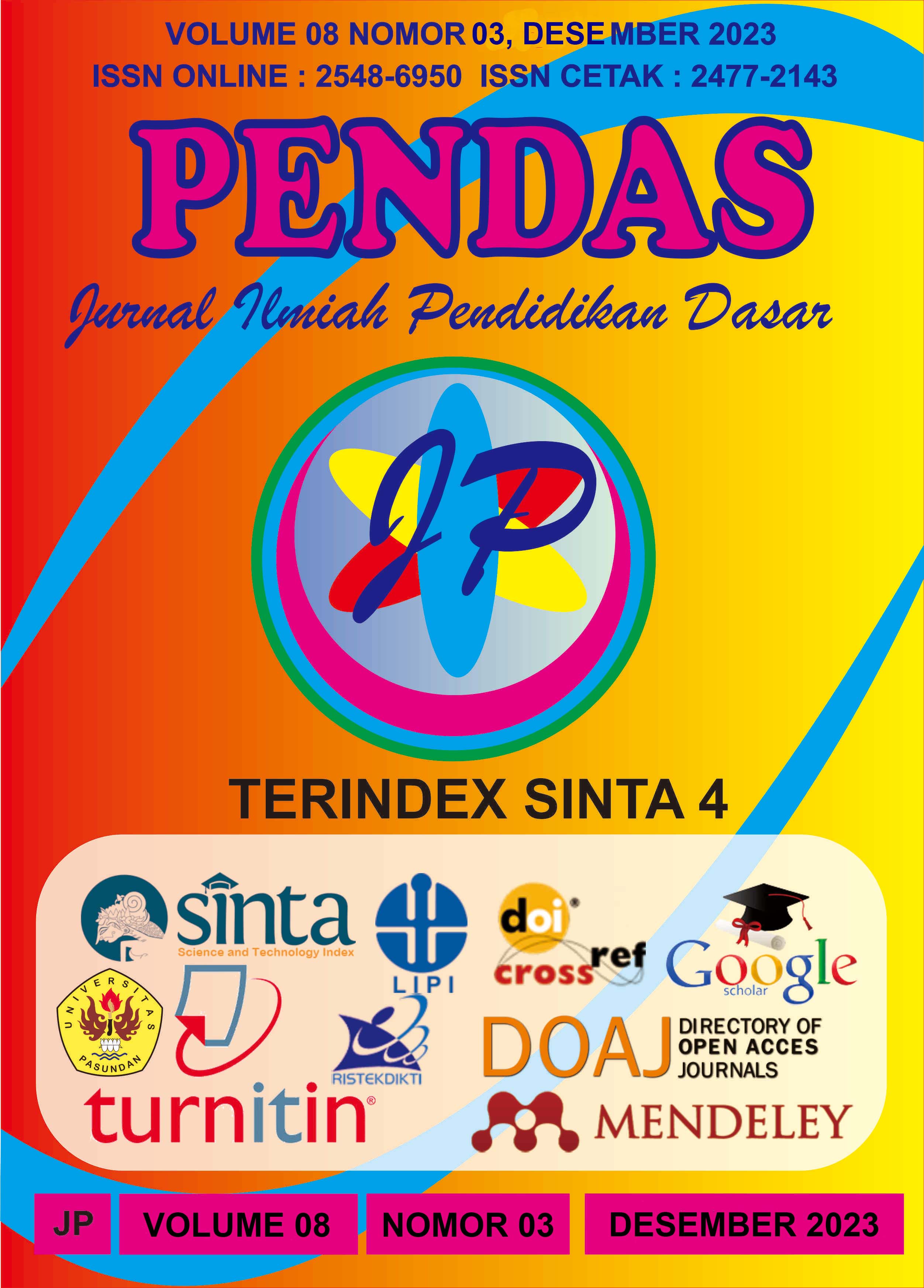ANALISIS FAKTOR UNTUK MENGETAHUI PENGARUH DISPOSISI MATEMATIS TERHADAP HASIL BELAJAR MATEMATIKA SISWA SMP
DOI:
https://doi.org/10.23969/jp.v8i3.11124Keywords:
Mathematical Disposition, Learning Outcomes, MathematicsAbstract
The low mathematics learning outcomes of class IX students are because students consider mathematics to be a difficult subject. Lack of sense of responsibility, self-confidence and enthusiasm in carrying out assignments, this relates to students' mathematical disposition. This research aims to determine the mathematical disposition indicators that most influence the learning outcomes of SMP 1 Saketi students. This research uses quantitative methods. The instruments used in this research were questionnaires and interviews. The questionnaire was distributed to 59 students in class IX B and IX F. The data analysis used is descriptive analysis and factor analysis. The results of the descriptive analysis show that the percentage results for each indicator fall within the criteria of 25% < P < 50%, which means that almost all students have mathematical disposition indicators. Meanwhile, the flexibility indicator is only 24%, including the criteria 0% < P < 25%, which means that a small percentage of students have the flexibility indicator. The results of factor analysis obtained 7 factors which are indicators of mathematical disposition, namely 1) persistence, 2) flexibility, 3) self-confidence 4) interest and curiosity, 5) appreciation of the role of mathematics, 6) reflective, and 7) assessing the role mathematics. Of the seven indicators formed, the persistence indicator is the indicator that has the most influence on student learning outcomes at SMP Negeri 1 Saketi with a percentage of variance of 25.799%Downloads
References
Agustyaningrum, N., & Suryantini, S. (2017). HUBUNGAN KEBIASAAN BELAJAR DAN KEPERCAYAAN DIRI DENGAN HASIL BELAJAR MATEMATIKA SISWA KELAS VIII SMP N 27 BATAM. Jurnal Ilmiah Pendidikan Matematika, 1(2), 158–164.
Arikunto, S. (2018). Prosedur Penelitian: Suatu Pendekatan Praktik. Rineka Cipta.
Ayu Lestari, L., Suharto, S., & Fatahillah, A. (2016). Analisis Pengaruh Disposisi Matematis terhadap Hasil Belajar Materi Integral Tak Tentu Siswa Kelas XII IPA 2 SMAN 4 Jember. Jurnal Edukasi, 3(1), 40–43.
Dewi, N., Asifa, S. N., & Zanthy, L. S. (2020). Pengaruh Kemandirian Belajar Siswa Terhadap Hasil Belajar Matematika. Pythagoras, 9(1), 48–54.
Itsar, P. A., Afifah, N. R., & Purrani, M. R. (2023). Analisis Konsentrasi Belajar Siswa dalam Proses Pembelajaran Matematika. 58, 261–266.
Izzah, A., Maghfiroh Az Zahra, S., & Ibrahim, I. (2022). Hubungan Antara Kemandirian Belajar dengan Disposisi Matematis Peserta Didik Kelas X Sekolah Menengah Atas ( SMA ). Polynom: Journal in Mathematics Education, 2(1), 1–7.
Izzati, N. (2017). Pengaruh Kemampuan Koneksi Dan Disposisi Matematis Terhadap Hasil Belajar Geometri Bidang Datar Mahasiswa Iain Syekh Nurjati Cirebon. Eduma : Mathematics Education Learning and Teaching, 6(2), 33–40.
Nasution, E. Y. P. (2018). Analisis Terhadap Disposisi Berpikir Kreatif Siswa Pada Pembelajaran Matematika. Edumatika : Jurnal Riset Pendidikan Matematika, 1(1), 44–55.
Nurul, N., Octaviani, A., & Zanthy, L. S. (2019). Analisis kemampuan koneksi matematis dan komunikasi matematis ditinjau dari kepercayaan diri siswa SMP. JPMI (Jurnal Pembelajaran Matematika Inovatif), 2(2), 57–64.
Oktavianti, M., & Munandar, D. R. (2023). Analisis Disposisi Matematis Siswa Kelas IX SMP Islam Al - Falah Bantargebang Kota Bekasi. Prosiding Seminar Nasional Matematika Dan Pendidikan Matematika (Sesiomadika) 2022, 180–190.
Purba, D., Zulfadli, & Lubis, R. (2021). Pemikiran George Polya Tentang Pemecahan Masalah. Jurnal MathEdu (Mathematic Education Journal), 4(1), 25–31.
Sari, J., & Sutirna, S. (2021). Analisis disposisi matematis siswa kelas VIII SMP negeri 3 karawang barat. MAJU: Jurnal Ilmiah Pendidikan Matematika, 8(1), 266–272.
Siregar, N. R. (2017). Persepsi Siswa Pada Pelajaran Matematika: Studi Pendahuluan Pada Siswa yang Menyenangi Game. Prosiding Temu Ilmiah X Ikatan Psikologi Perkembangan Indonesia, 224–232.
Sudjana, N. (2014). Penilaian Hasil Proses Belajar Mengajar. PT. Remaja Rosdakarya.
Suraji, Maimunah, & Saragih, S. (2018). Analisis Kemampuan Pemahaman Konsep Matematis dan Kemampuan Pemecahan Masalah Matematis Siswa SMP pada Materi Sistem Persamaan Linear Dua Variabel (SPLDV). Suska Journal of Mathematics Education, 4(1), 9–16.
Trisnowali, A. (2015). Profil Disposisi Matematis Siswa Pemenang Olimpiade Pada Tingkat Provinsi Sulawesi Selatan. Journal of Educational Science and Technology (EST), 1(3), 47–57.
Wanabuliandari, S. (2016). Peningkatan Disposisi Matematis Dengan Pengembangan Perangkat Pembelajaran Matematika Dengan Model Thinking Aloud Pairs Problem Solving (Tapps) Berbasis Multimedia. Refleksi Edukatika, 6(2), 138–144.
Widyawati, S. (2016). Pengaruh Gaya Belajar Terhadap Prestasi Belajar Mahasiswa Program Studi Pendidikan Matematika (IAIM NU) Metro. Al-Jabar : Jurnal Pendidikan Matematika, 7(1), 107–114.
Yulianti, D. E., Wuryanto, & Darmo. (2013). Keefektifan Model-Eliciting Activities Pada Kemampuan Penalaran Dan Disposisi Matematis Siswa. In Unnes Journal of Mathematics Education. (Vol. 1, Issue 1, pp. 17–23).
Downloads
Published
Issue
Section
License
Copyright (c) 2023 Pendas : Jurnal Ilmiah Pendidikan Dasar

This work is licensed under a Creative Commons Attribution 4.0 International License.



















